23 August, 2023
Here I’ll look at the top 6 most common running injuries (or foot / lower limb conditions) and my recommended shoes to help.
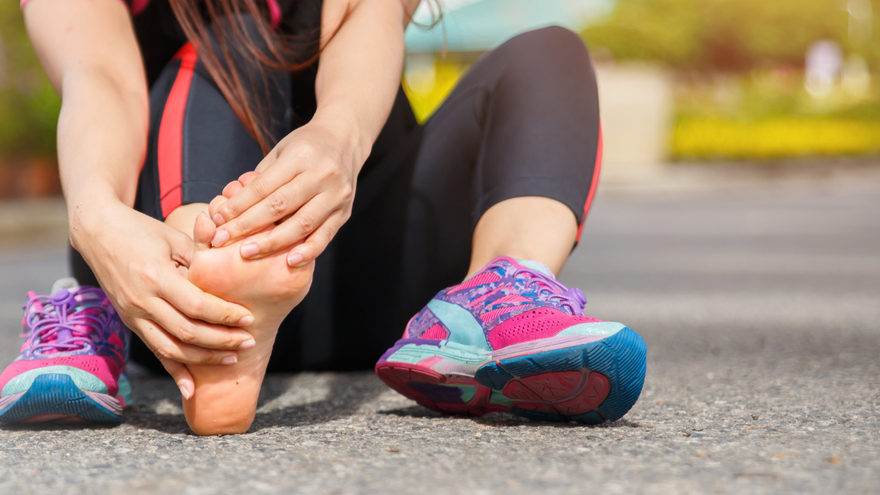
With over 25 years in the running footwear industry as well as being a qualified sports therapist and running coach, these shoe choices are based on my recommendations and experience from helping hundreds, if not thousands of runners choose the right shoe.
Of course, it’s always best in the first instance to rest or reduce the amount of training that you are doing if the injury isn’t getting better. I’d also recommend seeking professional medical advice regarding your injury.
For my top recommendations for the best shoes for the most common running injuries check out our picks below.
What is plantar fasciitis?
Plantar fasciitis is caused by straining the part of your foot that connects your heel bone to your toes (plantar fascia). The pain usually occurs under the heel and is most obvious when getting out of bed in the morning.
It's not always clear why this happens, but as runners possible causes include excessive over-pronation of the foot, tightness in the calf muscles, an increase in workload (not just running but perhaps during your usual day-to-day activities) and using shoes that are worn out or have very little support.
Whilst there are lots of possible treatments including the use of ice or rolling the foot over a tennis ball or similar, these usually only provide temporary relief from the pain and don’t treat the injury.
The best way to treat the injury is to strengthen the tendon and wear appropriate footwear. This includes during the day and at work if possible. It’s important to remember that you will spend much more time on your feet at work than you do running each day!
Price: £140
WEIGHT: Men’s 303gm / 10.7oz - Women’s 247g / 8.7 oz
HEEL STACK: 37mm TOE STACK: 25mm DROP: 12mm.
As plantar fasciitis usually occurs due to strain on the tendon, it’s common that runners are wearing shoes that lack support in the arch.
The Mizuno Wave Inspire 19 offers great support thanks to the Wave plate technology, but runners consistently tell me that they notice the structured shape of the support and fit through the arch and feel it’s providing a great fit in this area.
The 12mm drop also helps take some of the strain out of the calf and soleus muscle, again reducing the overall load and stress on the plantar fascia tendon.
Mizuno Enerzy foam cushioning provides a great, lightweight and responsive feel and elevates the shoe in terms of overall performance from many support shoes in this category.
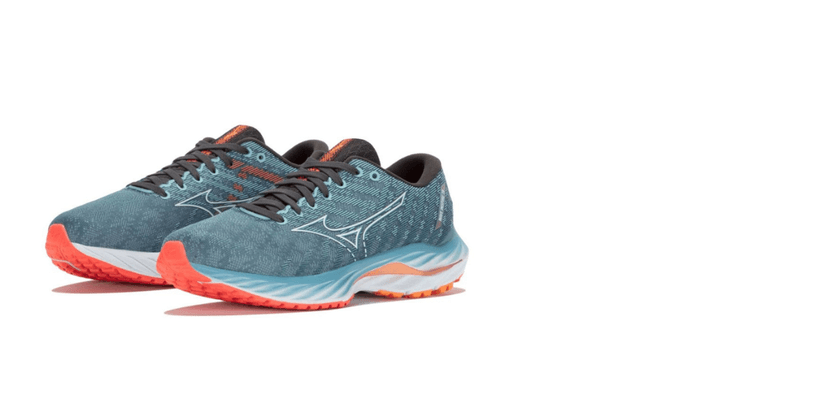
What is Achilles tendinopathy?
Achilles tendinopathy occurs when your Achilles tendon becomes damaged and stops working as well as it should. It’s usually damaged through repeated use and injury over time. The damage can make it painful and harder to do your usual activities.
Sometimes Achilles tendinopathy will be referred to as Achilles tendonitis. This means your tendon is inflamed. But because there isn’t always inflammation when your tendon is injured, this term isn’t strictly accurate.
For runners, the most common contributing factor is excessive pronation of the foot. This is what is commonly known as overpronation or supination.
The movement puts additional strain on the tendon and essentially nips the tendon at the area close to the top of your shoe in the heel. The twisting and nipping reduce circulation and contribute to the soreness.
Price: £135
WEIGHT: Men’s 286gm / 10.1oz - Women’s 258g / 9.1 oz
HEEL STACK: 36mm TOE STACK: 24mm DROP: 12mm.
As a major contributor to Achilles tendinopathy is excessive pronation the Brooks Adrenaline GTS23 is a great choice of shoe thanks to its use of the brand’s ‘GuideRail’ technology.
The GuideRails are extensions of the shoe's cushioning that rise up around the rear of the foot. Should the foot roll in (over-pronate) or out (supinate) the GuideRails act to reduce this movement and keep the foot in a more neutral position.
Unlike other support category shoe options, the use of the GuideRails provides general all-around support and control so is a very safe option. If the foot rolls either way, the support and control is there, likewise, should the foot not roll the guide rails won’t affect the natural movement.
The cushioning in the Brooks Adrenaline GTS23 comes from the brand's tried and tested DNA LOFT material, a soft but stable material that also offers great durability.
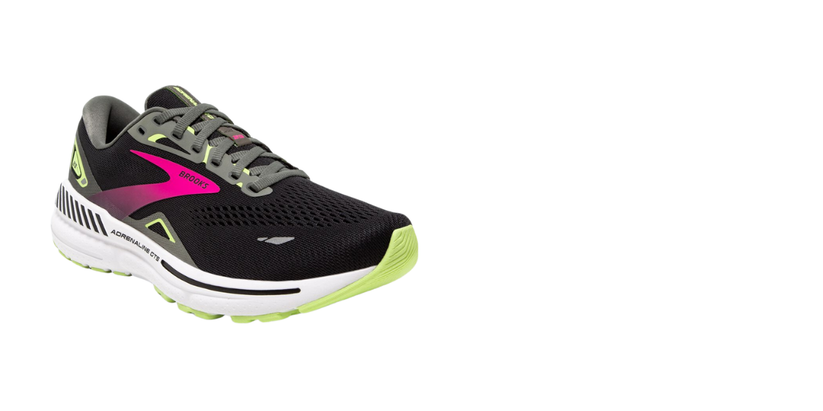
What are bunions?
Bunions are bony lumps that form on the side of the feet. Surgery is the only way to get rid of them, but there are things you can do to ease any pain they cause.
Unfortunately, without surgery, the bunion won’t go away, so the best you can do is accommodate the ‘bump’ within your footwear.
If you experience pain within the joint of the big toe joint, then a supportive shoe, such as the Mizuno Wave Inspire 19 above or the Brooks Adrenaline GTS22 also above may help. In the case of the Brooks, it is available in different width fittings which will prove more space.
Price: £130
WEIGHT: Men’s 278gm / 9.8oz - Women’s 230g / 8.1oz
HEEL STACK: 30mm TOE STACK: 30mm DROP: Zero mm.
With the brand's unique Foot-Shaped toe box, the Torin 7 offers plenty of space in the forefoot to accommodate bunions. Ok, foot widths will vary, as will the shape and size of an individual's bunion, but in general, Altra shoes are a great option here.
Their balanced ride provides a deep, 30mm stack of cushioning throughout the length of the shoe courtesy of the Altra EGO Max foam. This places the foot at an equal distance from the ground giving a more natural foot strike.
The upper of the latest version of the Torin features a neat, engineered mesh upper with nice padding around the heel and Achilles. Despite the broad, foot-shaped forefoot the shoe has a snug fit around the midfoot and fits well.
The foot-shaped last may also be a good choice for those with Morton’s neuroma, a condition where a benign neuroma is trapped, most commonly between the second and third metatarsals causing pain and discomfort. The additional space within the Torin 7 could help alleviate this pain, allowing the metatarsals to spread naturally.
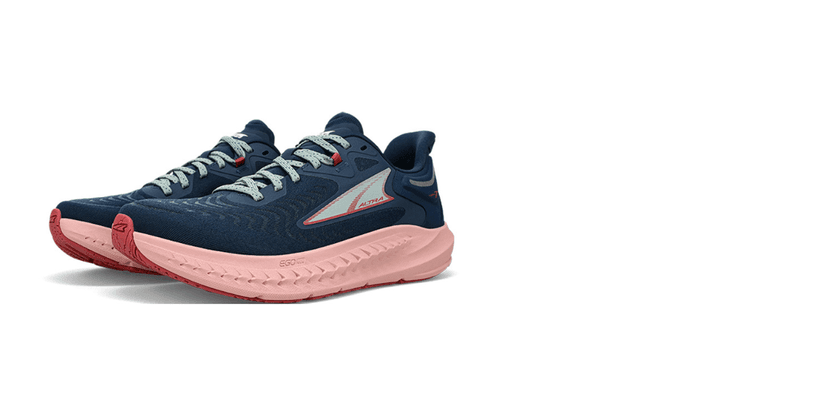
What is runner’s knee?
Runner’s knee is a general umbrella term for a range of knee-related issues. Most commonly it’s associated with general pain under and around the patella.
Many schools of thought consider the heel drop of a shoe as a factor to help reduce the load on the knee and therefore knee pain. A higher-drop shoe could put additional pressure on the front of the knee, while a shoe with a lower heel drop can reduce this load.
Many shoes and brands traditionally have a heel drop of around 12mm. The heel drop is the difference between the height of the cushioning under the heel compared to that under the forefoot.
Price: £130
WEIGHT: Men’s 250gm / 8.8oz - Women’s 221g / 7.8oz
HEEL STACK: 35mm TOE STACK: 27mm DROP: 8mm.
Brands such as Brooks, Mizuno, New Balance and ASICS have heels drops of around 10 to 12mm in many of their models.
Altra models such as the Torin 7 featured above have a zero-drop or, as they refer to it, a balanced ride. While this would certainly be the lowest drop you could have it may take a little while to get used to.
The Saucony Ride 16 features an 8mm drop, so for many may be a little less than they are used to and provide enough relief from stress on the knees.
The PWRRUN foam midsole provides a soft stack of cushioning with slightly higher sidewalls for stability to keep the foot (and more importantly the knee) stable.
It has a smooth riding feel with a forefoot rocker that’s a little more prominent than many brands. This rocker shape provides a faster-rolling feel and helps make this a great shoe at a variety of speeds.
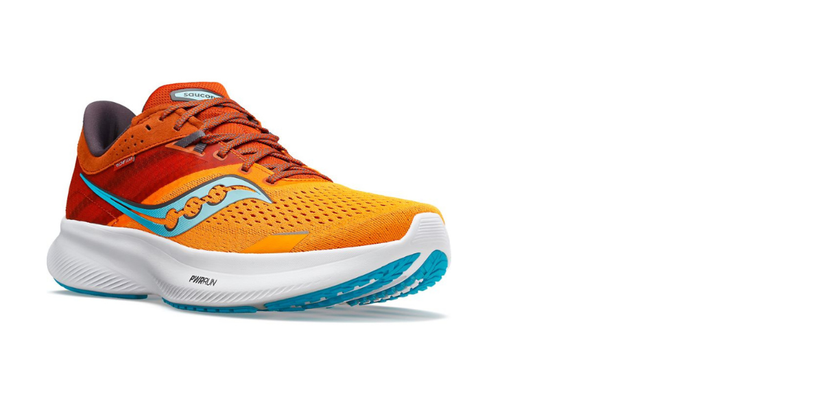
What are shin splints?
The term ‘shin splints’ usually refers to pain along the shin bone (tibia), the large bone in the front of your lower leg.
Generally known as an overuse injury, shin splints are medically known as medial tibial stress syndrome often occurring in athletes who have recently intensified or changed their training routines. The increased activity overworks the muscles, tendons and bone tissue.
Most cases of shin splints can be treated with rest, ice and other self-care measures.
Price: £170
WEIGHT: Men’s 274gm / 9.7oz - Women’s 249g / 8.8oz
HEEL STACK: 37mm TOE STACK: 27mm DROP: 10mm.
Being an overuse injury there can be several contributing factors. Simply increasing the amount of running you are accustomed to is the most common.
If the cushioning in your shoes has become worn out or compressed this can increase the load on the muscles in the lower legs and in turn the risk of shin splints.
With this in mind, a running shoe with good cushioning is the first port of call.
The Saucony Triumph 21 is the brand’s premium cushioned model featuring a deep stack of PWRRUN+ cushioning. PWRRUN+ brings the performance feel of the brand's best racing shoes into a training model for everyday use.
The shoe soaks up the impact of every stride and on push-off provides an energised feel that brings a smile to your face with the almost bouncy ride!
It’s a stable ride too, feeling great at any speed and any type of run. Built to go the distance the feel of the PWRRUN+ cushioning maintains its cushioning qualities throughout the life of the shoe helping to make this a great choice for those with shin splint concerns.
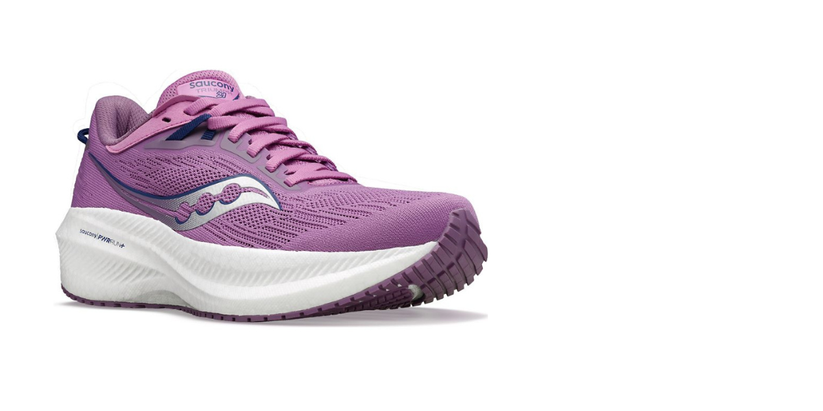
What is ITB syndrome?
Ilio-tibial band (ITB) syndrome is an injury to a part of your knee. Your IT band is a thickened band of tissue that runs down the length of the outside of your thigh.
Your IT band works with your knee ligaments to help stabilise your knee joint. ITB syndrome happens when your IT band rubs repeatedly against the lower end of your thigh bone as it joins your knee. This friction causes inflammation and pain.
Price: £175 / $160
WEIGHT: Men’s 290gm / 10.2oz - Women’s 260g / 9.2oz
HEEL STACK: 30mm TOE STACK: 22mm DROP: 8mm.
In my experience, I’ve found that those suffering from IT band pain are wearing shoes that are too stiff or supportive for their foot type. For example, wearing support shoes essentially ‘pushes’ their foot out (supinate). This puts additional stress on the lateral side of the knee, contributing to the IT band pain.
The ASICS Gel Nimbus 25 offers a soft and accommodating ride thanks to its FF BLAST PLUS cushioning which tends to help the foot pronate naturally and therefore take the strain off the lateral side of the knee.
New PUREGEL is encapsulated within the midsole to further add to the cushioning and helps to keep the overall weight of the shoe down.
The upper of the Nimbus 25 is one of the best uppers of any shoe on the market right now. Its stretch, lightweight engineered mesh design wraps around the foot beautifully with a soft plush feel while offering all-around support.
Whilst the Nimbus 25 offers almost maximal levels of cushioning, it’s not a highly responsive ride. Here that’s not an issue as it’s all about the cushioning and the shoe's ability to soak up the impact and balance the foot into a neutral position.
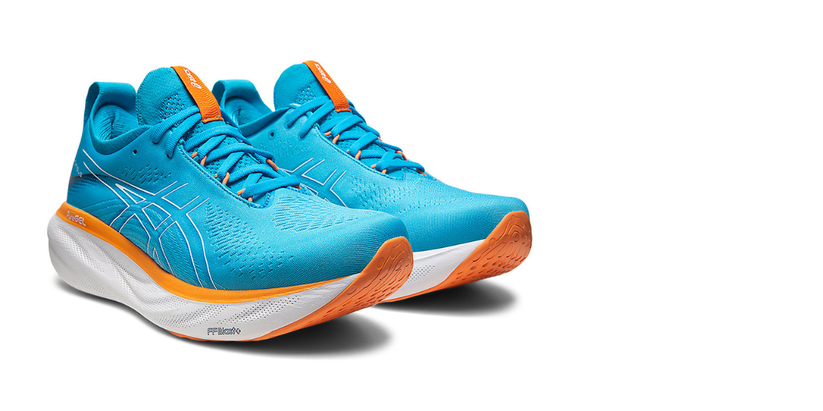
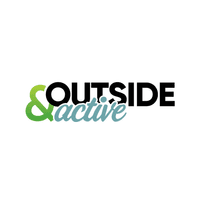
Outside & Active is the home for those who love the outdoors. Our mission is to inspire, inform and educate people about being active outdoors in a fun, safe and sustainable way. We provide inspiration, kit, tech and advice on adventure, camping, climbing, cycling, hiking, running water and winter.
Most recent articles by Outside & Active

Brooks supports trail runners to defy limits and empower their trail runs with the new Cascadia 18. The adaptable Cascadia combines DNA Loft v2 cushioning with TrailTack Green grip and a durable upper mesh to handle all terrains, providing necessary comfort and underfoot security on each surface.

Connectivity makes eBiking more customised, convenient and secure.

Various app solutions, interfaces and services as the next step for the eBike experience of tomorrow
Most recent articles in RUNNING

Why is diet such a contentious topic in ultrarunning and why do I call it a myth? These are the topics that I will discuss in this article.

In my last piece for Outside & Active, I talked about what I believed the worst mistake a runner could make is.

Brooks supports trail runners to defy limits and empower their trail runs with the new Cascadia 18. The adaptable Cascadia combines DNA Loft v2 cushioning with TrailTack Green grip and a durable upper mesh to handle all terrains, providing necessary comfort and underfoot security on each surface.